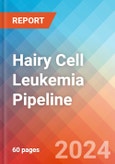Hairy Cell Leukemia Understanding
Hairy Cell Leukemia: Overview
Hairy cell leukemia (HCL) is a relatively rare chronic B-cell malignancy that involves the bone marrow, spleen, and peripheral blood. The complete blood count may reveal pancytopenia including monocytopenia. Median age at diagnosis is approximately 55. Poor prognostic features, while somewhat variable in the literature, may include age, hemoglobin less than 10 g/dL, platelets less than 100, ANC less than 1000, the presence of lymphadenopathy, and massive splenomegaly.The etiology of hairy cell leukemia is not well elucidated. However, previous exposure to various chemicals may play a role in its development. Most cases are postulated to be derived from V600E BRAF gene mutation of late activated memory B cells. As a lymphoproliferative neoplasm, Hairy cell leukemia is a clonal disorder. The relatively recent discovery of the presence of the V600E BRAF mutation in the vast majority of cases of classic Hairy cell leukemia has suggested that the pathogenesis of this disorder lies in the RAS-RAF-MAPK signaling pathway. Given its incurable nature, hairy cell leukemia treatment is reserved for symptomatic patients, including significant fatigue, symptomatic splenomegaly, and significant cytopenias Asymptomatic individuals should be monitored closely for disease progression with history and physical and CBC approximately every 3 to 6 months.
'Hairy Cell Leukemia - Pipeline Insight, 2025' report outlays comprehensive insights of present scenario and growth prospects across the indication. A detailed picture of the Hairy Cell Leukemia pipeline landscape is provided which includes the disease overview and Hairy Cell Leukemia treatment guidelines. The assessment part of the report embraces, in depth Hairy Cell Leukemia commercial assessment and clinical assessment of the pipeline products under development. In the report, detailed description of the drug is given which includes mechanism of action of the drug, clinical studies, NDA approvals (if any), and product development activities comprising the technology, Hairy Cell Leukemia collaborations, licensing, mergers and acquisition, funding, designations and other product related details.
Report Highlights
The companies and academics are working to assess challenges and seek opportunities that could influence R&D Hairy Cell Leukemia. The therapies under development are focused on novel approaches to treat/improve Hairy Cell Leukemia.This segment of the Hairy Cell Leukemia report encloses its detailed analysis of various drugs in different stages of clinical development, including phase II, I, preclinical and Discovery. It also helps to understand clinical trial details, expressive pharmacological action, agreements and collaborations, and the latest news and press releases.
Hairy Cell Leukemia Emerging Drug
Ibrutinib: Johnson & Johnson
Ibrutinib was one of the first therapies to receive U.S. approval after having received the FDA's Breakthrough Therapy Designation. IMBRUVICA works by blocking a specific protein called Bruton's tyrosine kinase (BTK).1 The BTK protein transmits important signals that tell B cells to mature and produce antibodies and is needed by specific cancer cells to multiply and spread. Ibrutinib targets and blocks BTK, inhibiting cancer cell survival and spread.Hairy Cell Leukemia: Therapeutic Assessment
This segment of the report provides insights about the Hairy Cell Leukemia drugs segregated based on following parameters that define the scope of the report, such as:Major Players in Hairy Cell Leukemia
There are approx. 5+ key companies which are developing the therapies Hairy Cell Leukemia. The companies which have their Hairy Cell Leukemia drug candidates in the most advanced stage, i.e Phase II include, Johnson & Johnson.Phases
The report covers around 5+ products under different phases of clinical development like
- Late stage products (Phase III)
- Mid-stage products (Phase II)
- Early-stage product (Phase I) along with the details of
- Pre-clinical and Discovery stage candidates
- Discontinued & Inactive candidates
Route of Administration
Hairy Cell Leukemia pipeline report provides the therapeutic assessment of the pipeline drugs by the Route of Administration. Products have been categorized under various ROAs such as- Oral
- Intravenous
- Subcutaneous
Molecule Type
Products have been categorized under various Molecule types such as
- Small molecule
- Cell Therapy
- Peptides
- Polymer
- Small molecule
- Gene therapy
Product Type
Drugs have been categorized under various product types like Mono, Combination and Mono/Combination.Hairy Cell Leukemia: Pipeline Development Activities
The report provides insights into different therapeutic candidates in phase II, I, preclinical and discovery stage. It also analyses Hairy Cell Leukemia therapeutic drugs key players involved in developing key drugs.Pipeline Development Activities
The report covers the detailed information of collaborations, acquisition and merger, licensing along with a thorough therapeutic assessment of emerging Hairy Cell Leukemia drugs.Hairy Cell Leukemia Report Insights
- Hairy Cell Leukemia Analysis
- Therapeutic Assessment
- Unmet Needs
- Impact of Drugs
Hairy Cell Leukemia Report Assessment
- Pipeline Product Profiles
- Therapeutic Assessment
- Pipeline Assessment
- Inactive drugs assessment
- Unmet Needs
Key Questions
Current Treatment Scenario and Emerging Therapies:
- How many companies are developing Hairy Cell Leukemia drugs?
- How many Hairy Cell Leukemia drugs are developed by each company?
- How many emerging drugs are in mid-stage, and late-stage of development for the treatment of Hairy Cell Leukemia?
- What are the key collaborations (Industry-Industry, Industry-Academia), Mergers and acquisitions, licensing activities related to the Hairy Cell Leukemia therapeutics?
- What are the recent trends, drug types and novel technologies developed to overcome the limitation of existing therapies?
- What are the clinical studies going on for Hairy Cell Leukemia and their status?
- What are the key designations that have been granted to the emerging drugs?
Key Players
- Johnson & Johnson
- Amega Biotech
- LAVA Therapeutics
Key Products
- Ibrutinib
- Interferon alpha-2a
- LAVA 1266
This product will be delivered within 2 business days.
Table of Contents
Companies Mentioned (Partial List)
A selection of companies mentioned in this report includes, but is not limited to:
- Johnson & Johnson
- Amega Biotech
- LAVA Therapeutics








